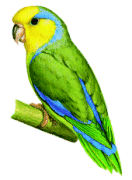[order] PSITTACIFORMES | [family] Psittacidae | [latin] Forpus xanthops | [authority] Salvin, 1895 | [UK] Yellow-faced Parrotlet | [FR] Toui a tete jaune | [DE] Gelbmasken-Sperlingspapagei | [ES] Cotorrita Carigualda | [NL] Geelwangmuspapegaai | [copyright picture] Birdlife
Subspecies
Monotypic species
Genus
The genus Forpus consists of seven recognized species that are distributed in the lowlands of South America and Mexico. The Forpus genus is one of the few groups of parrots where females differ markedly from males. They are the smallest birds in the Psittaformes order.
Physical charateristics
Male-bright yellow forehead, crown, cheeks and throat; occiput and nape purple/grey, extending in a stripe to eye; olive/grey mantle, upper back and lesser wing coverts to scapulars and inner secondary feathers; deep blue lower back, rump, upper tail coverts and underwing coverts; purple/blue secondary coverts; inner primary feathers suffused with blue at bases; green/yellow underparts. Bill horn in colour with grey at base of upper mandible. Eye brown. Female-as in male but lower back and rump paler blue in colour; primary and secondary coverts, secondary feathers and bases to primary feathers all green tinged with blue.
Listen to the sound of Yellow-faced Parrotlet
[audio:http://www.planetofbirds.com/MASTER/PSITTACIFORMES/Psittacidae/sounds/Yellow-faced Parrotlet.mp3]
Copyright remark: Most sounds derived from xeno-canto
recorded by David Beadle
| wingspan min.: | 0 | cm | wingspan max.: | 0 | cm |
| size min.: | 15 | cm | size max.: | 16 | cm |
| incubation min.: | 21 | days | incubation max.: | 22 | days |
| fledging min.: | 35 | days | fledging max.: | 40 | days |
| broods: | 2 | eggs min.: | 3 | ||
| eggs max.: | 6 |
Range
South America : Northcentral Peru. Endemic of Peru it occurs in the upper Maranon valley, in south Amazonas, south-east Cajamarca and east La Libertad, north-central Peru. Most recent records originate from the Balsas area Amazonas/Cajamarca) and the Chagual/Hacienda Soquian area (La Libertad), but intervening areas are considerably less accessible.
Habitat
It inhabits arid woodland, riparian thickets and desert scrub at 800-2,750 m, but mostly at 1,000-1,600 m.
Reproduction
In captivity, 3-6 eggs are laid which are incubated for about 3 weeks, and up to three broods are raised per year. Young fledge after about 5-6 weeks. In the wild, the breeding season begins in March-April, and nesting takes place in natural dirt and rock walls, in colonies of up to 70 birds. Sometimes old woodpecker nests are used.
Feeding habits
It is the most restricted of any member of its genus and occurs in small inconspicuous flocks in cactus-scrub montane desert, dry deciduous scrub and riparian thickets which feed on the fruits or seeds of leguminous trees, cactuses and flowers.
Video Yellow-faced Parrotlet
httpv://www.youtube.com/watch?v=JqIOyed50PA
copyright: Luc Fazio
Conservation
A ban on trapping and trade has improved the status of this species. The rate of decline was very rapid in the 1980s, but may now have reduced, or even stabilised. However, the population remains very small, with records from very few locations, and it consequently qualifies as Vulnerable.
It was formerly abundant, but suffered a serious decline, probably during the 1980s, when it became rare in the more accessible areas. In 1988, numbers were extremely low, with only 168 individuals counted during extensive surveys. It appears to be recovering somewhat following a ban on trade, and the number of birds traded has fallen markedly. However, there is little evidence of a substantial recovery. Trapping for the local cage-bird trade is probably the sole reason for its recent and drastic decline.
It was formerly abundant, but suffered a serious decline, probably during the 1980s, when it became rare in the more accessible areas. In 1988, numbers were extremely low, with only 168 individuals counted during extensive surveys. It appears to be recovering somewhat following a ban on trade, and the number of birds traded has fallen markedly. However, there is little evidence of a substantial recovery. Trapping for the local cage-bird trade is probably the sole reason for its recent and drastic decline.

Migration
Sedentary
Distribution map


